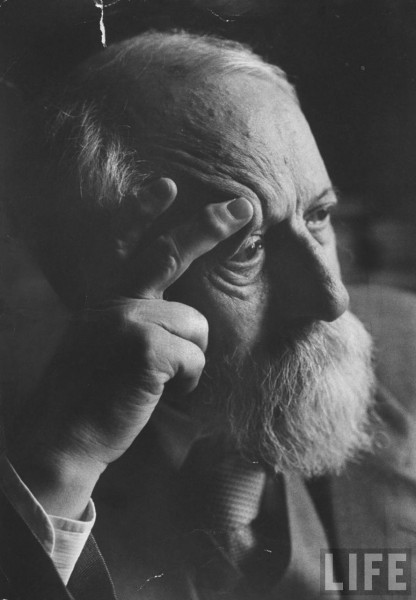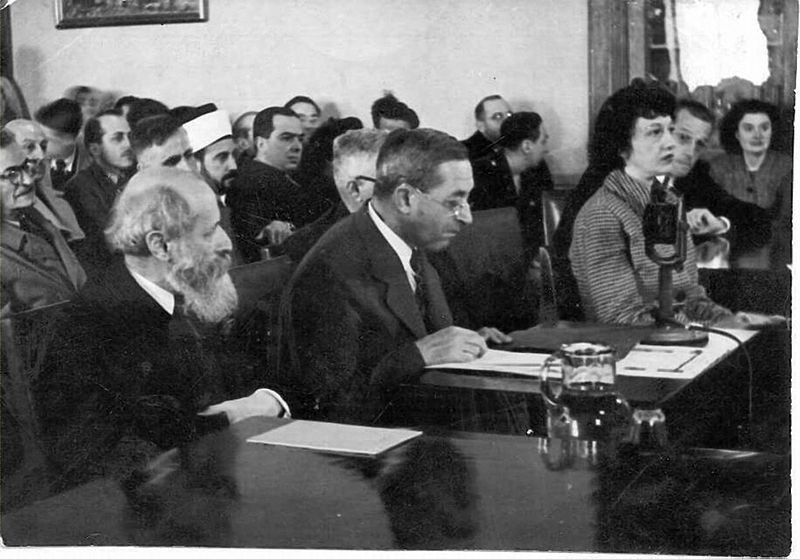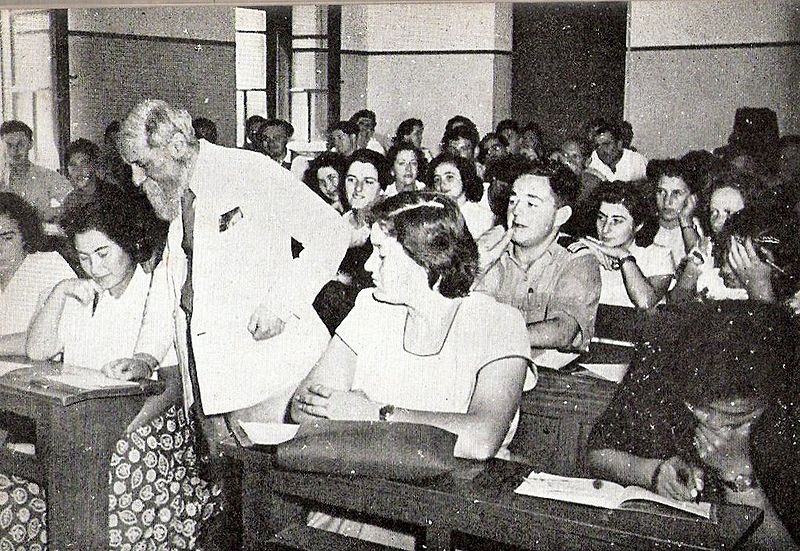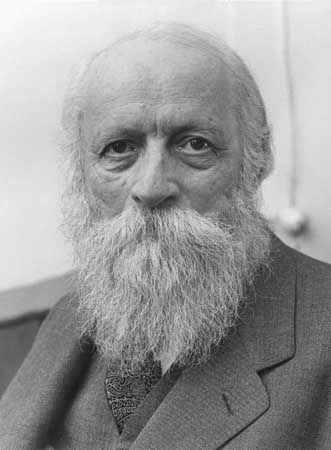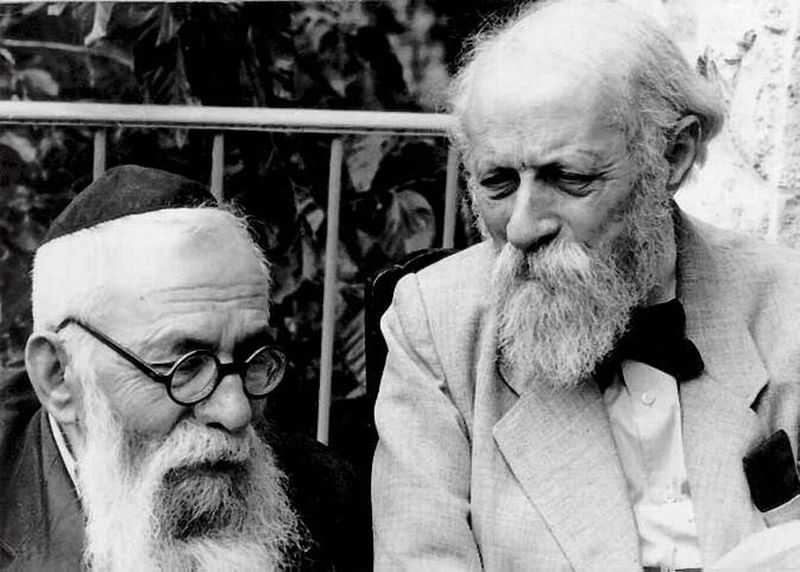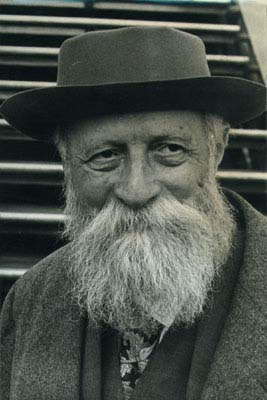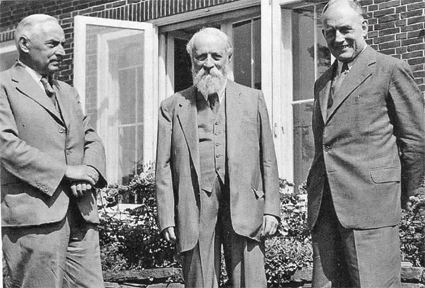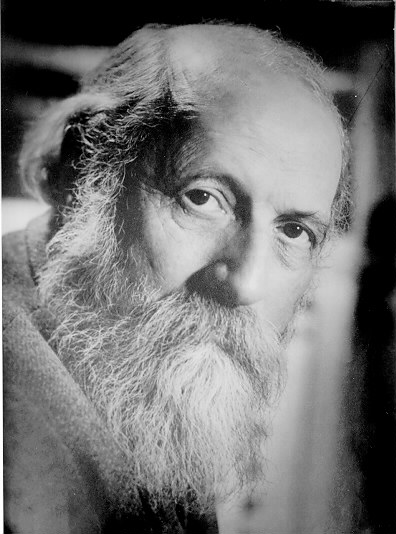<Back to Index>
- Philosopher Martin Buber, 1878
PAGE SPONSOR
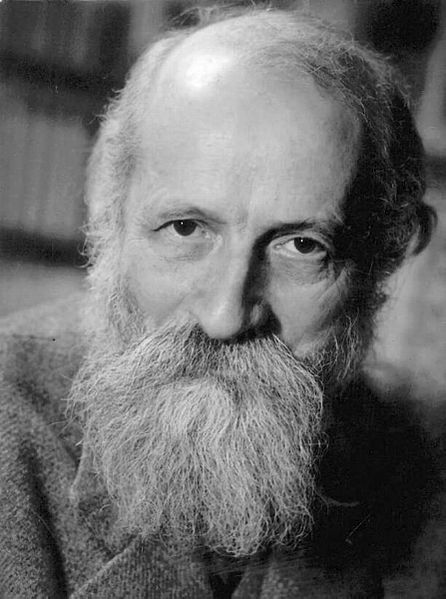
Martin Buber (Hebrew: מרטין בובר; February 8, 1878 – June 13, 1965) was an Austrian born Jewish philosopher best known for his philosophy of dialogue, a form of religious existentialism centered on the distinction between the I-Thou relationship and the I-It relationship. Born in Vienna, Buber came from a family of observant Jews, but broke with Jewish custom to pursue secular studies in philosophy. In 1902, Buber became the editor of the weekly Die Welt, the central organ of the Zionist movement, although he later withdrew from organizational work in Zionism. In 1923 Buber wrote his famous essay on existence, Ich und Du (later translated into English as I and Thou), and in 1925 he began translating the Hebrew Bible into the German language.
In 1930 Buber became an honorary professor at the University of Frankfurt am Main, and resigned in protest from his professorship immediately after Adolf Hitler came to power in 1933. He then founded the Central Office for Jewish Adult Education, which became an increasingly important body as the German government forbade Jews to attend public education. In 1938, Buber left Germany and settled in Jerusalem, in the British Mandate for Palestine, receiving a professorship at Hebrew University and lecturing in anthropology and introductory sociology.
Buber's wife Paula died in 1958, and he died at his home in the Talbiyeh neighborhood of Jerusalem on June 13, 1965.
Martin (Hebrew name: מָרְדֳּכַי, Mordechai) Buber was born in Vienna to an Orthodox Jewish family. His grandfather, Solomon Buber, in whose house in Lemberg (now Lviv, Ukraine) Buber spent much of his childhood, was a renowned scholar of Midrash and Rabbinic Literature. At home Buber spoke Yiddish and German. In 1892, Buber returned to his father's house in Lemberg.
A personal religious crisis led him to break with Jewish religious customs: he started reading Immanuel Kant, Søren Kierkegaard, and Friedrich Nietzsche. The latter two, in particular, inspired him to pursue studies in philosophy. In 1896, Buber went to study in Vienna (philosophy, art history, German studies, philology).
In 1898, he joined the Zionist movement, participating in congresses and organizational work. In 1899, while studying in Zürich, Buber met his future wife, Paula Winkler, a non - Jewish Zionist writer from Munich who later converted to Judaism.
Buber's evocative, sometimes poetic writing style has marked the major themes in his work: the retelling of Hasidic tales, Biblical commentary, and metaphysical dialogue. A cultural Zionist, Buber was active in the Jewish and educational communities of Germany and Israel. He was also a staunch supporter of a binational solution in Palestine,
and after the establishment of the Jewish state of Israel, of a
regional federation of Israel and Arab states. His influence extends
across the humanities, particularly in the fields of social psychology, social philosophy, and religious existentialism.
Approaching Zionism from his own personal viewpoint, Buber disagreed with Theodor Herzl about the political and cultural direction of Zionism. Herzl envisioned the goal of Zionism in a nation - state, but did not consider Jewish culture or religion necessary. In contrast, Buber believed the potential of Zionism was for social and spiritual enrichment. Herzl and Buber would continue, in mutual respect and disagreement, to work towards their respective goals for the rest of their lives.
In 1902, Buber became the editor of the weekly Die Welt, the central organ of the Zionist movement. However, a year later Buber became involved with the Jewish Hasidism movement.
Buber admired how the Hasidic communities actualized their religion in
daily life and culture. In stark contrast to the busy Zionist
organizations, which were always mulling political concerns, the Hasidim
were focused on the values which Buber had long advocated for Zionism
to adopt. In 1904, Buber withdrew from much of his Zionist
organizational work and devoted himself to study and writing. In that
year he published his thesis: Beiträge zur Geschichte des Individuationsproblems (on Jakob Böhme and Nikolaus Cusanus).
From 1910 to 1914, Buber studied myths and published editions of mythic texts. In 1916 he moved from Berlin to Heppenheim.
During World War I he helped establish the Jewish National Commission in order to improve the condition of Eastern European Jews. During that period he became the editor of Der Jude (German for "The Jew"), a Jewish monthly (until 1924). In 1921 Buber began his close relationship with Franz Rosenzweig. In 1922 Buber and Rosenzweig co-operated in Rosenzweig's House of Jewish Learning, known in Germany as Lehrhaus.
In 1923 Buber wrote his famous essay on existence, Ich und Du (later translated into English as I and Thou). Though he edited the work later in his life, he refused to make substantial changes. In 1925 he began, in conjunction with Franz Rosenzweig, translating the Hebrew Bible into German. He himself called this translation Verdeutschung ("Germanification"), since it does not always use literary German language but attempts to find new dynamic (often newly invented) equivalent phrasing in order to respect the multivalent Hebrew original. Between 1926 and 1930 Buber co-edited the quarterly Die Kreatur ("The Creature").
In 1930 Buber became an honorary professor at the University of Frankfurt am Main. He resigned in protest from his professorship immediately after Adolf Hitler came to power in 1933. On October 4, 1933 the Nazi authorities forbade him to lecture. In 1935 he was expelled from the Reichsschrifttumskammer (the National Socialist authors' association). He then founded the Central Office for Jewish Adult Education, which became an increasingly important body as the German government forbade Jews to attend public education. The Nazi administration increasingly obstructed this body.
Finally, in 1938, Buber left Germany and settled in Jerusalem, then capital of Mandate Palestine. He received a professorship at Hebrew University there, lecturing in anthropology and introductory sociology. He participated in the discussion of the Jews' problems in Palestine and of the Arab question – working out of his Biblical, philosophic, and Hasidic work.
He became a member of the group Ichud, which aimed at a bi-national state for Arabs and Jews in Palestine. Such a binational confederation was viewed by Buber as a more proper fulfillment of Zionism than a solely Jewish state. In 1946 he published his work Paths in Utopia, in which he detailed his communitarian socialist views and his theory of the "dialogical community" founded upon interpersonal "dialogical relationships".
After World War II Buber began giving lecture tours in Europe and the USA.
- In 1951, Buber received the Goethe award of the University of Hamburg.
- In 1953, he received the Peace Prize of the German Book Trade.
- In 1958, he was awarded the Israel Prize in the humanities.
- In 1961, he was awarded the Bialik Prize for Jewish thought.
- In 1963, he won the Erasmus Prize in Amsterdam.
In 2005, he was voted the 126th greatest Israeli of all time, in a poll by the Israeli news website Ynet to determine whom the general public considered the 200 Greatest Israelis.
Buber is famous for his thesis of dialogical existence, as he described in the book I and Thou.
However, his work dealt with a range of issues including religious
consciousness, modernity, the concept of evil, ethics, education, and
Biblical hermeneutics.
In I and Thou, Buber introduced his thesis on human existence. Inspired partly by Feuerbach's The Essence of Christianity and Kierkegaard's "Single One", Buber worked upon the premise of existence as encounter. He explained this philosophy using the word pairs of Ich-Du and Ich-Es to categorize the modes of consciousness, interaction, and being through which an individual engages with other individuals, inanimate objects, and all reality in general. Philosophically, these word pairs express complex ideas about modes of being – particularly how a person exists and actualizes that existence (existentialism). As Buber argues in I and Thou, a person is at all times engaged with the world in one of these modes.
The generic motif Buber employs to describe the dual modes of being is one of dialogue (Ich-Du) and monologue (Ich-Es). The
concept of communication, particularly language oriented communication,
is used both in describing dialogue / monologue through metaphors and
expressing the interpersonal nature of human existence.
Ich-Du ("I-Thou" or "I-You") is a relationship that stresses the mutual, holistic existence of two beings. It is a concrete encounter, because these beings meet one another in their authentic existence, without any qualification or objectification of one another. Even imagination and ideas do not play a role in this relation. In an I-Thou encounter, infinity and universality are made actual (rather than being merely concepts). Buber stressed that an Ich-Du relationship lacks any composition (e.g. structure) and communicates no content (e.g. information). Despite the fact that Ich-Du cannot be proven to happen as an event (e.g. it cannot be measured), Buber stressed that it is real and perceivable. A variety of examples are used to illustrate Ich-Du relationships in daily life – two lovers, anno no non non
One key Ich-Du relationship Buber identified was that which can exist between a human being and God. Buber argued that this is the only way in which it is possible to interact with God, and that an Ich-Du relationship with anything or anyone connects in some way with the eternal relation to God.
To
create this I-Thou relationship with God, a person has to be open to
the idea of such a relationship, but not actively pursue it. The pursuit
of such a relation creates qualities associated with It-ness, and so
would prevent an I-You relation, limiting it to I-It. Buber claims that
by being open to the I-Thou, God eventually comes to us in response to
our welcome. Also, because the God Buber describes is completely devoid
of qualities, this I-Thou relation lasts as long as the individual wills
it. When the individual finally returns to the I-It, they act as a
pillar of deeper relation and community.
The Ich-Es ("I-It") relationship is nearly the opposite of Ich-Du. Whereas in Ich-Du the two beings encounter one another, in an Ich-Es relationship the beings do not actually meet. Instead, the "I" confronts and qualifies an idea, or conceptualization, of the being in its presence and treats that being as an object. All such objects are considered merely mental representations, created and sustained by the individual mind. This is based partly on Kant's theory of phenomenon, in that these objects reside in the cognitive agent’s mind, existing only as thoughts. Therefore, the Ich-Es relationship is in fact a relationship with oneself; it is not a dialogue, but a monologue.
In the Ich-Es relationship, an individual treats other things, people, etc., as objects to be used and experienced. Essentially, this form of objectivity relates to the world in terms of the self – how an object can serve the individual’s interest.
Buber argued that human life consists of an oscillation between Ich-Du and Ich-Es, and that in fact Ich-Du experiences are rather few and far between. In diagnosing the various perceived ills of modernity (e.g.
isolation, dehumanization, etc.), Buber believed that the expansion of a
purely analytic, material view of existence was at heart an advocation
of Ich-Es relations
– even between human beings. Buber argued that this paradigm devalued not only existents, but the meaning of all existence.
Ich und Du has been translated from the original German into many other languages. However, because Buber's use of German was highly idiomatic and often unconventional, there has naturally been debate on how best to convey the complex messages in his text. One critical debate in the English speaking world has centered around the correct translation of the key word pairs Ich-Du and Ich-Es. In the German the word "Du" is used, while in the English two different translations are used: "Thou" (used in Ronald Smith’s version) and "You" (used by Walter Kaufmann). The key problem is how to translate the very personal, even intimate German "Du", which has no direct equivalent in Modern English. Smith argued that "Thou" invokes the theological and reverential implications which Buber intended (e.g. Buber describes God as the eternal "Du"). Kaufmann asserted that this wording was archaic and impersonal, offering "You" because (like the German Du) it has colloquial usage in intimate conversation.
Despite this debate, Buber’s book is widely known in the English speaking world as I and Thou,
perhaps because the Smith translation appeared years before the
Kaufmann one. However, both the Smith and Kaufmann translations are
widely available.
Buber was a scholar, interpreter, and translator of Hasidic lore. He viewed Hasidism as a source of cultural renewal for Judaism, frequently citing examples from the Hasidic tradition that emphasized community, interpersonal life, and meaning in common activities (e.g. a worker's relation to his tools). The Hasidic ideal, according to Buber, emphasized a life lived in the unconditional presence of God, where there was no distinct separation between daily habits and religious experience. This was a major influence on Buber's philosophy of anthropology, which considered the basis of human existence as dialogical.
In 1906, Buber published Die Geschichten des Rabbi Nachman, a collection of the tales of the Rabbi Nachman of Breslov, a renowned Hasidic rebbe, as interpreted and retold in a Neo - Hasidic fashion by Buber. Two years later, Buber published Die Legende des Baalschem (stories of the Baal Shem Tov), the founder of Hasidism.
Buber's interpretation of the Hasidic tradition, however, has been criticized by scholars such as Chaim Potok for its romanticization. In the introduction to Buber's Tales of the Hasidim,
Potok notes that Buber overlooked Hasidism's "charlatanism,
obscurantism, internecine quarrels, its heavy freight of folk
superstition and pietistic excesses, its tzadik worship,
its vulgarized and attenuated reading of Lurianic Kabbalah." Even more
severe is the criticism that Buber de-emphasized the importance of the
Jewish Law in Hasidism. This is ironic, considering that Buber often
delved into Hasidim to demonstrate that individual religiosity did not
require a dogmatic, creedal religion.
Already in the early 1920s Martin Buber started advocating a binational Jewish-Arab state, stating that the Jewish people should proclaim "its desire to live in peace and brotherhood with the Arab people and to develop the common homeland into a republic in which both peoples will have the possibility of free development."
Buber rejected the idea of Zionism as just another national movement and wanted instead to see the creation of an exemplary society; a society which would not, he said, be characterized by Jewish domination of the Arabs. It was necessary for the Zionist movement to reach a consensus with the Arabs even at the cost of the Jews remaining a minority in the country. In 1925 he was involved in the creation of the organization Brit Shalom (Covenant of Peace), which advocated the creation of a binational state, and throughout the rest of his life he hoped and believed that Jews and Arabs one day would live in peace in a joint nation. In 1942, he co-founded the Ihud party which advocated a binationalist program. Nevertheless he was connected with decades of friendship to Zionists and philosophers like Chaim Weizmann, Max Brod, Hugo Bergman and Felix Weltsch, who were close friends of his from old European times in Prague, Berlin and Vienna to the Jerusalem of the 1940s, 50s, and 60s.
After
the Israeli state gained independence in 1948, Buber advocated Israel's
participation in a federation of "Near East" states wider than just
Palestine.
